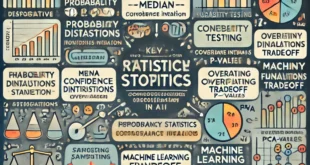Bidirectional Encoder Representations from Transformers (BERT) has revolutionized the field of natural language processing (NLP). Developed by Google in 2018, BERT introduced a powerful new approach to how machines understand the context of words in a sentence. Unlike previous models, which processed text in a unidirectional manner (either from left to right or right to left), BERT’s bidirectional architecture allows …
Read More »Mudasir Syed
Meta Llama 4: Redefining Open-Source AI with Multimodal Mastery and Unprecedented Scale
April 6, 2025 – In a landmark move for artificial intelligence, Meta has officially launched Llama 4, its most advanced open-source AI model family to date. Released on April 5, 2025, this suite of models combines revolutionary architecture, multimodal capabilities, and industry-leading performance – all while maintaining Meta’s commitment to open-source accessibility. With three specialized models (Scout, Maverick, and Behemoth), …
Read More »Understanding Outliers in Machine Learning: A Comprehensive Guide
In the realm of machine learning, data quality is essential. Subpar data quality can result in erroneous models and deceptive insights, rendering it essential to detect and rectify anomalies inside datasets. Outliers are among the most prevalent data quality concerns. This blog will examine the concept of outliers, their influence on machine learning models, and effective methods for managing them—utilizing …
Read More »How can we implement an MLP with 1×1 Convolution: A Deep Dive into Advanced Architectures
Introduction Machine learning (ML) and deep learning have progressed swiftly in the past decade, transforming domains such as computer vision, natural language processing, and robotics. Among the numerous designs available, the integration of Multilayer Perceptrons (MLP) with convolutional processes has garnered significant attention. Although convolutions are generally linked to Convolutional Neural Networks (CNNs), their integration with Multi-Layer Perceptrons (MLPs) can …
Read More »Handling Missing Data: Manual Methods and AI Models
Missing data is a prevalent obstacle in data analysis and machine learning. This blog will examine the management of missing data through manual techniques and AI models, accompanied by practical examples. Understanding Missing Data Missing data denotes the lack of a value in a dataset when information is anticipated. This may arise from multiple factors, including data input inaccuracies, sensor …
Read More »A Comprehensive Guide to Statistics for AI
Statistics constitutes the foundation of artificial intelligence (AI). Statistical methods offer the instruments necessary for the interpretation, modeling, and analysis of data, ranging from comprehension of data distributions to the construction of machine learning models. This blog will guide you through the basic statistical principles necessary for students aspiring to flourish in AI. 1. Introduction to Statistics in AI Statistics …
Read More »How to Install Conda on Windows, macOS, and Linux
Among data scientists, developers, and machine learning practitioners, Conda is an open-source package management system and environment management tool that is rather popular. It streamlines handling dependencies, environments, and program versions. This page will walk you methodically through installing Conda on Linux, macOS, and Windows. What is Conda? Conda functions as a comprehensive package manager that facilitates the creation of …
Read More »The Latest Microsoft Small Language Model, Phi-4, Emphasizes Complex Reasoning
Improvements in language modeling and reasoning capacities are propelling the artificial intelligence (AI) sector toward ever-faster evolution. Leading the charge in this innovation is Microsoft’s latest Phi-4, a state-of-the-art small language model (SLM) with 14 billion parameters that is highly adept at complicated reasoning, especially in mathematical subjects. Phi-4, the newest member of the Phi family, proves that small, specialized …
Read More »Meta Llama 3.3: A Game-Changer in Multilingual AI and Efficient Model Performance
Llama 3.3, the most recent version from Meta AI, is a major step forward in the evolution of LLMs. The latest version of Llama, 3.3, which was officially released on December 7, 2024, has 70 billion parameters and is an extremely efficient model with multilingual capabilities and practical deployment capabilities that push the bounds. Although Llama 2.5 and Llama 2 …
Read More »Google Dino Run: An Infinite Runner Game Created in Python
The simplistic yet addictive gameplay of endless runner games has made them a mainstay in the gaming industry. Here we will have a look at the Python and Pygame libraries to see how you can make your very own Dino Run, an endless runner game. This game takes its cues from the original Chrome Dino, but it has its own …
Read More » AI Generated Apps AI Code Learning Technology
AI Generated Apps AI Code Learning Technology









